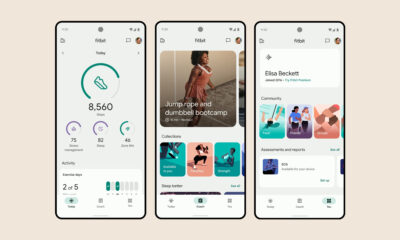News
Fitbit Unveils 3 New Fitness Trackers — Without Wear OS 3
The svelte updates to the Inspire, Versa, and Sense models still don’t use Google’s wearable OS, though the range still looks tempting.
If you were eagerly awaiting a new smartwatch release from Fitbit that would feature an updated OS in the form of Google Wear 3, you’ll probably be disappointed by the firm’s latest announcement. However, that’s perhaps as far as bad news goes for this new range of fitness trackers, as overall, the trio of models otherwise look incredibly compelling.
The Inspire 3, Versa 4, and Sense 2 are all now available for preorder, with each model looking a little slimmer and more polished than before, albeit sporting Fitbit’s own OS instead of the Google iteration. Fitbit’s software is attractive and easy enough to use, and you’ll still be able to access maps and wallet features from the search giant despite not getting the full Wear OS treatment.
Light Fantastic
At $100, the Inspire 3 is the entry-level model and compares favorably to the likes of Garmin’s Vivosmart series.
The always-on AMOLED face and 10-day battery life are notable in this price tier, as are the monitoring features, which boast:
- Always-on tracking for blood oxygen (SpO2).
- Always-on skin temperature monitor.
- Irregular heartbeat rhythm warning.
The watch has also received FDA approval and CE marking, so you can be sure the device will keep a watchful eye over your vital signs. As well as comprehensive monitoring, you also get a Daily Readiness score, helping you decide whether you need to recover or head out for another training session, and a new Sleep Profile feature able to track 10 different sleep metrics.
The Inspire 3 comes in three colors and can be fitted with a wide range of new Fitbit bands too.
A Genuine Apple Alternative?
The Versa 4 ($230) and Sense 2 ($300) aim to take a slice of the Apple Watch’s market share, though, of course, both devices work with Android and iOS, so offer a good deal more flexibility than Cupertino’s walled garden device.
Both Fitbit trackers have overhauled software, tweaked to offer a (dare we say) more Apple-like vibe. However, unlike Apple’s devices, they will comfortably last a whole week on a charge and refill to a day’s worth of power in just 12 minutes.
Features include everything present on the Inspire 3, with the Versa 4 being optimized for workouts, using built-in GPS and 40 exercise modes. The Sense 2 now features a Body Response sensor that hunts for stress triggers and alerts the wearer if anything troubling is uncovered.
Both watches are also lighter and thinner than previous iterations, with the entire lineup offering a slimmer, smarter experience all around.
News
Google Releases Veo 2 AI Video Tool To MENA Users
The state-of-the-art video generation model is now available in Gemini, offering realistic AI-generated videos with better physics, motion, and detail.

Starting today, users of Gemini Advanced in the MENA region — and globally — can tap into Veo 2, Google’s next-generation video model.
Originally unveiled in 2024, Veo 2 has now been fully integrated into Gemini, supporting multiple languages including Arabic and English. The rollout now brings Google’s most advanced video AI directly into the hands of everyday users.
Veo 2 builds on the foundations of its predecessor with a more sophisticated understanding of the physical world. It’s designed to produce high-fidelity video content with cinematic detail, realistic motion, and greater visual consistency across a wide range of subjects and styles. Whether recreating natural landscapes, human interactions, or stylized environments, the model is capable of interpreting and translating written prompts into eight-second 720p videos that feel almost handcrafted.
Users can generate content directly through the Gemini platform — either via the web or mobile apps. The experience is pretty straightforward: users enter a text-based prompt, and Veo 2 returns a video in 16:9 landscape format, delivered as an MP4 file. These aren’t just generic clips — they can reflect creative, abstract, or highly specific scenarios, making the tool especially useful for content creators, marketers, or anyone experimenting with visual storytelling.
Also Read: Getting Started With Google Gemini: A Beginner’s Guide
To ensure transparency, each video is embedded with SynthID — a digital watermark developed by Google’s DeepMind. The watermark is invisible to the human eye but persists across editing, compression, and sharing. It identifies the video as AI-generated, addressing concerns around misinformation and media authenticity.
While Veo 2 is still in its early phases of public rollout, the technology is part of a broader push by Google to democratize advanced AI tools. With text-to-image, code generation, and now video creation integrated into Gemini, Google is positioning the platform as a full-spectrum creative assistant.
Access to Veo 2 starts today and will continue expanding in the coming weeks. Interested users can try it out at gemini.google.com or through the Gemini app on Android and iOS.






















